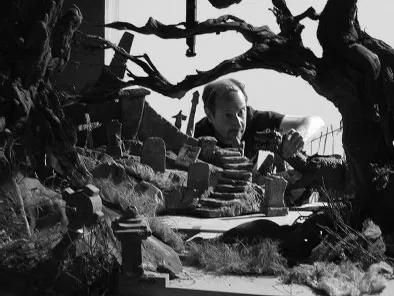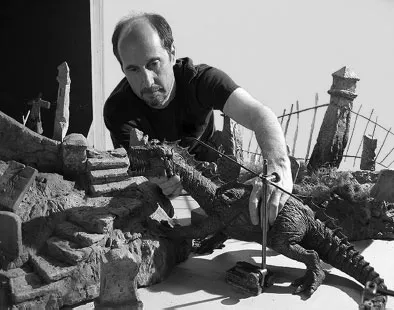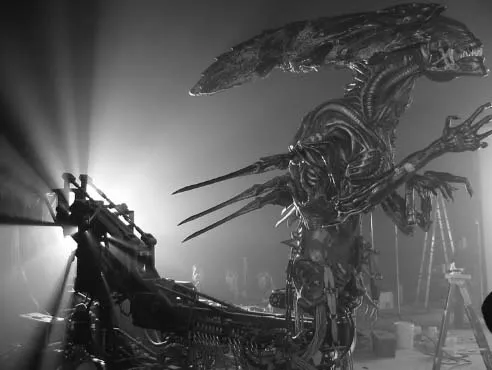![]()
Part 1
VISUAL EFFECTS IN REVIEW
![]()
1
THE “GOOD” OLD DAYS: VISUAL EFFECTS BEFORE COMPUTERS
Until fairly recently, the art and craft of visual effects went by the name special photographic effects because the work was accomplished photographically on film and relied heavily on special optical cameras called optical printers. Most of the serious visual effects work took place in postproduction. Nowadays we simply call it visual effects. But even defining a visual effect is far from straightforward. For one thing, some people include visual effects in the general category of special effects, while others may refer to them as special visual effects.
Visual effects have been a part of the filmmaker’s creative toolbox almost from the first time a cinematographer cranked a handle on a wooden camera back in the 1890s.
The first known visual effect that seems to have survived was created in 1895 in a short film called The Execution of Mary, Queen of Scots. In that historic piece, an actress portraying the ill-fated queen puts her head on a chopping block. A hooded executioner raises his axe and brings it down on the neck of the victim, whose severed head rolls free onto the ground. The story goes that viewers were shocked by this unprecedented bit of cinema magic: the simple enough trick of stopping the camera at the appropriate moment and substituting a dummy for the actress, then resuming. Viewers of that era knew nothing about jump cuts or other visual trickery that even a 10-year-old youngster raised in today’s media environment would recognize instantly.
Of course, that begs the question, what is a visual effect? Everyone seems to have a different definition, which only goes to show that the term’s exact meaning is hard to pin down. Even the Visual Effects Society (which ought to know) hasn’t come up with a satisfactory definition. Not too many years ago, it was relatively easy to say what a visual effect was: If a shot required some sort of treatment in postproduction and rephotographing on an optical printer, it was called a “special photographic effect.” John Dykstra, one of the top visual effects supervisors in the business today (and one of the main creative forces behind the visual effects for the seminal film Star Wars of 1977), once defined a visual effect as “two or more elements of film combined into a single image.” That was a perfectly reasonable definition … until computers replaced optical printers and he modified that definition by saying that “with the advent of digital imaging, that could be considered two or more subjects captured in a separate media and made to appear (italics added) as if they were photographed together.”1 The key phrase here is “made to appear as if they were photographed together.” Unless a visual effects shot maintains that illusion, no amount of technical wizardry is going to convince a viewer of the reality of the shot.
On one point most people in the industry would probably agree: Visual effects involve some form of image manipulation. That precept gives rise to the somewhat broader definition that we prefer: A visual effect is the manipulation of moving images by photographic or digital means that creates a photorealistic cinematic illusion that does not exist in the real world. These effects invariably involve some sort of photographic or digital trickery. Let’s face it: We’re in the business of deceiving audiences.
We’re quick to admit that this a somewhat broad definition (would that make slow-motion or timelapse photography a “visual effect”?), but it has the virtue that it allows us to include certain cinematic techniques under the heading of Visual Effects that don’t necessarily require the combination of more than one visual element to make up the final shot (case in point: in-camera miniatures).
With that definition as a guide (and on the assumption that the reader already has a good understanding of film fundamentals), here follows a brief compilation of visual effects techniques that filmmakers have used over time, and that, either by themselves or in combination with digital techniques, are still useful today. Readers may notice that several techniques we describe here are accomplished all in-camera. As such, they don’t necessarily qualify as true visual effects as we define the term. Nevertheless, we chose to include these techniques because they become the responsibility of the visual effects producer on many productions.
SUCCESS STORY
Lynda Thompson - (Evan Almighty; Haunted Mansion)
The first film I worked on was Tron … I was an assistant scene coordinator and I learned about animation, animation cameras, and the specifics of visual effects while working directly with a wonderful mentor … For the next 10 years I worked on numerous films as a VFX Coordinator and a VFX Production Supervisor. I also had the opportunity to work at several different companies and that added to my learning experience. In those days credits were still evolving and I received the title VFX Producer for the first time on Dave in 1993.
I have been working as a VFX Producer for over 15 years … My father and grandfather were both in visual effects but I graduated from the University of California, Irvine, with a B.A. in English and initially thought I would go a different route and become a journalist. Now I can’t imagine that I almost made that choice.
The essential duties of the VFX Producer are breaking down the script, budgeting the VFX, overseeing the production of the VFX during prep/shoot/post and communicating well with the production and VFX teams. The responsibility of the VFX Producer is to facilitate delivery of final shots within the agreed-upon budget and time.
Keys to Success: Being able to see potential problems well in advance is one of the most important qualities for the job. A VFX Producer is responsible for keeping everything running smoothly. I believe the best VFX Producers steer the team away from pitfalls in a calm, decisive manner. The database keeps us informed on each shot’s current status, an essential part in being able to meet the production schedule with final quality effects shots.
Stop-Motion Animation
Stop-motion animation is probably the oldest visual effects technique. It is based on the ability of a motion picture camera to shoot a series of frames one at a time instead of in a continuous burst of film, as is normally the case. As early as 1897, two American film pioneers produced a short film called Humpty Dumpty Circus in which they moved a child’s toys by stop-motion, and in 1898 the French film pioneer Georges M é li è s used stop-motion to animate wooden letters for what today we would call a commercial.
Stop-motion animation is a bit like traditional two-dimensional (2D) cartoon (or cel) animation in that an animator makes small changes in the subject’s position from one frame to the next. In traditional animation, the animator creates the sense of movement by drawing a character on paper or a 2D sheet of acetate (called the cel) in a slightly different position in each frame. But in stop-motion, the animator moves a three-dimensional (3D) model in small increments from one frame to the next so that its movements will look smooth and continuous when the film is projected at the normal 24 frames per second. The technique is also called “dimensional animation.” Undoubtedly the most famous practitioner of this technique is the legendary Ray Harryhausen. He inspired a whole generation of animators and present-day visual effects artists with his classic stop-motion work in movies like the original Mighty Joe Young (1949), Jason and the Argonauts (1963), Clash of the Titans (1981), and many others.
The technique is still very much alive today, but today’s stop-motion animators have a wide array of digital and electronic gadgetry at their disposal that enables them to create some truly wonderful animation. In fact, we would argue that it was the development of sophisticated electronic and digital tools that led to a revival in recent years of stop-motion films. Beginning with The Nightmare before Christmas (1993), followed in 2000 by the hit Chicken Run and later by such delightful stop-motion masterpieces as Corpse Bride (2005) and Coraline (2009), stop-motion artists could avail themselves of such technological innovations as motion control, digital image manipulation, and digital compositing that did not exist in precomputer times.
The technique does have its limitations, especially in today’s filmmaking environment where many stories that might have been told with puppets in the past can now be presented more realistically through digitally created characters. But stop-motion has always worked best when it was in the service of fantasy and legends, rather than literal reality. It is this quality that gave films like James and the Giant Peach (1996) their charm and lent an air of whimsy to the undersea creatures of The Life Aquatic with Steve Zissou (2004). The tradition continues with films like Coraline (2009) and Mary and Max (2009), made by creative filmmakers who devote their artistic energies to this oldest of visual effects techniques.
Figure 1.1 Stop-motion animator Stephen Chiodo on stop-motion set. (Image courtesy of Chiodo Bros.)
Figure 1.2 Animator Stephen Chiodo poses a dragon puppet.
(Image courtesy of Chiodo Bros.)
Puppets and Animatronics
Puppets are artificial creations that simulate a living creature, whether human or not. Puppets can be animated very simply by hand, wires, cables, rods, or—more likely these days—animatronics. Strictly speaking, animatronics is the control of motorized puppets through the use of electronics. But over time, the word animatronics has become kind of a catch-all term that covers electronic, mechanical, hydraulic, or radio-control devices. We just need to be clear that when we say that something is animatronic, we are merely talking about how a character is animated, or made to move. It does not mean that the entire character is artificial. In other words, a puppet is artificial by definition, but it is not necessarily animatronic.
Figure 1.3 Full-scale animatronic Alien Queen from Alien VS. Predator, making use of a combination of electronics, hydraulics, and a computer-controlled performance system.
(Image courtesy of Amalgamated Dynamics, Inc. Alien VS. Predator © 2004 Twentieth Century Fox. All rights reserved)
Matte Paintings
A matte painting is a painting that adds to or replaces part of a live action image. Matte paintings are used to create imaginary environments or to replace part of a scene to add complexity to a shot that would otherwise be too expensive or impossible to film. They have been called the invisible art, because when they are done well, viewers cannot tell that they are looking at a painting.
Matte paintings have their roots in what are called glass shots, a technique that predates motion pictures. Early still photographers would sometimes aim their cameras at a subject and find that the existing scene was not to their liking. Their solution lay in setting up a pane of glass between the camera and the subject, then painting a different scene directly on the glass so that the painting blended seamlessly with the subject they wanted to photograph.
It was just such a photographer, Norman Dawn, who was apparently the first cinematographer to apply the glass-shot technique to motion pictures, after having learned the trick while a still photographer. Unfortunately, glass shots had to be set up and completed at whatever location the action took place, be it city or desert, come rain or come shine. Glass shots enhanced many a film for decades, but they were gradually replaced by true matte paintings after the invention of optical printers in the 1920s. With optical printers, a live action scene could be filmed on location, but the accompanying painting could be completed at a more leisurely pace in the studio.
Figure 1.4 Matte artist Syd Dutton of Illusion Arts at work on a digital matte painti...




